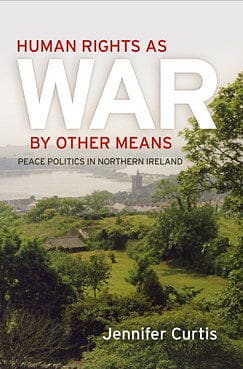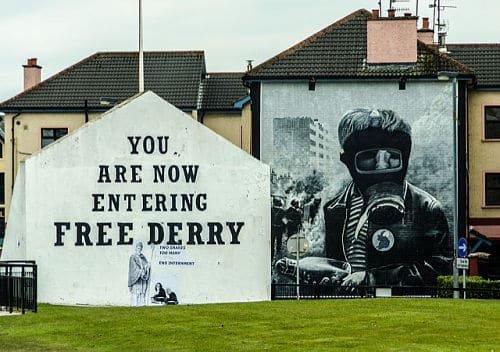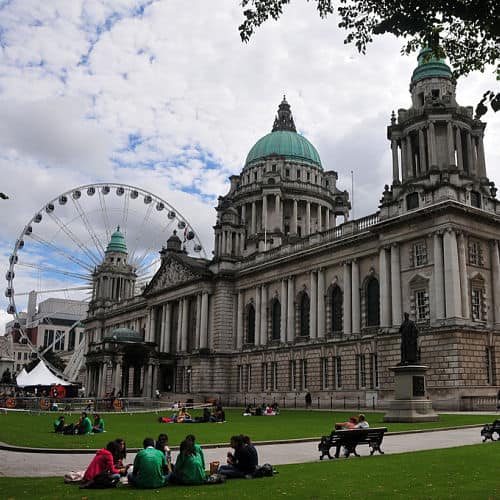There has, of late, been a loud and to some extent circular debate within the field of human rights studies. The debate is over whether or not one can – or should – tell the history of human rights. In one sense, the critics of such historical endeavours are, in my opinion, correct – the point is not simply to interpret rights, but to find alternatives. But the critique put forth before this observation is only part of the story – and the history of human rights only part of a much-needed inquiry into this very contemporary phenomenon. Rather, we need an investigation into exactly how it is that human rights operate, not simply at an abstract – or even global – level, as thinkers like Talal Asad, Jacques Ranciere, Miriam Ticktin and Ilana Feldman, among others, have brought to our attention, but within the confines of a particular problem-space.

Her compelling account of conflict, community activism, and the peace process exposes the contradictions inherent to human rights discourse.
It tells of the ways in which human rights theory and practice have overwritten other narratives of the conflict and even undermined the gains of the peace process, thus continuing the war “by other means”. The ‘villain’ of the story is the unfortunate cocktail of consociational institutions and collective rights: rather than defusing conflict, they fracture society further along ethnopolitical lines, presenting a political narrative that explains the past and the future of the conflict in terms of rights (p.128).
Now, the peace process in Northern Ireland depicts past violence as a response to a lack of rights accorded by the state. Hence, the solution proposed to end the conflict was to strengthen rights (p.39). Curtis’ ethnography examines the contradictory results of this push for rights. It focuses on the Falls (nationalist) and Shankhill (unionist) areas of West Belfast, highlighting two crucial aspects of the conflict. One hinges around the Good Friday Agreement, which re-wrote the narrative of conflict in terms of rights, paving the way for communalism. The second is the question of economic rights and distributive justice. Of particular interest is the story Curtis tells of benefits and entitlements, which lends texture to our understanding of the conflict between rights and inequality. Both illuminate why exactly contemporary political narratives about human rights – and the insistence that they are the source material for peacebuilding and the solution for conflicts – can be dangerous.
Spotlighting both the discourse and the legal tools of human rights in Northern Ireland, Curtis demonstrates how institutional frameworks like the Good Friday Agreement (GFA) and their offspring (human rights commissions) created new legal and political structures. The GFA was committed to “parity of esteem” for the two communities, which Curtis argues institutionalised the politics of collective rights by legally recognising two communities and their respective entitlements to human rights (p.101-102). This rights discourse of “parity of esteem” led to the ethnopoliticisation of rights and the intensification of conflict around the political rights of assembly and expression, since these rights were “reinterpreted as of collective, communal subjects” (p.121).

Photo by master phillip (flickr, CC BY-NC-ND 2.0)
Curtis’ ethnography also demonstrates the effects of expertise unmoored from its institutional home and set loose in the world, as in the case of the GFA, which was based on the work of political scientist Arendt Lijphart. Her nuanced account charts the shifts in how the conflict was framed over time, showing that specific narratives have had profound consequences in real life. These claims were broadly based on civil rights in the 1960s, economic rights in the 1970s and 1980s, and finally, political rights and human rights after the early 1990s. Tracing these various iterations of claim-making, Curtis shows the concomitant professionalisation, and – perhaps unwitting – complicity of community activism in crafting a hegemonic rights narrative.
One of the major critiques of human rights has been that they constrain distributive justice. Robert Meister, for example, has shown how the narrow definition of human rights abuses as bodily injury in post-Apartheid South Africa has precluded claims for economic redistribution (Meister 2012). Curtis’s ethnographic account tells a slightly different story. By explaining how claims around economic inequality and welfarism structured the discourse of peace and rights in Northern Ireland, Curtis’ ethnography complicates Samuel Moyn’s argument that “human rights concern status but not distributive equality” (Moyn 2015).
In the case of Northern Ireland, rights discourse was organised around equal distribution of economic resources. But the rise of economic rights discourse was a double-edged sword.
The 1980s saw a shift from economic rights to civil rights and the language of discrimination. International rights activist Sean MacBride developed a set of 9 affirmative action principles (related to recruiting employees) for international companies that invested in Northern Ireland, and economic rights became framed as Catholic disadvantage (p.96-98). The effect, Curtis argues, was that ethnopolitics displaced economic rights and normalised inequality (p.98-100). In fact, “The discourse of economic rights remained construed in terms of communal gains and losses, and more robust, sustained claims for economic rights did not materialize. In the 1980s, persistent rhetorical reductions of economic rights to communal advantage helped establish an important human rights domain as a theater for war by other means” (p.100).

Photo by mariusz kluzniak (flickr, CC BY-NC-ND 2.0)
In the final chapter, Curtis’ argument that “gay rights campaigners have created new politics” (p.170) is perhaps the least convincing. True, they differ from the dominant discourse of rights that focuses on ethnicity. However, the reclamation of public spaces and the re-direction of rights discourse does not seem so much like a “new politics” as it does an extension of already–existing politics. In extending existing rights (as opposed to creating new ones) this activism still falls squarely within the language and discourse of human rights, rather than offering alternate political practices. Furthermore, given recent work on homonationalism and the gay international (e.g. Puar 2007), we would be wise to be wary of such configurations of rights claims.
Overall, Human Rights As War By Other Means is an important contribution to ethnographies of rights, showing us not only how rights discourse can derail peace and dehistoricise conflict, but also how it can rearrange the world by strengthening communal divisions and rewriting futures.
The narrative of human rights in Northern Ireland that Curtis lays out makes plain the fact that human rights are, to put it somewhat crudely, “uncontainable”.
Works Cited
Meister, Robert. After Evil: A Politics of Human Rights. New York: Columbia University Press, 2012. Print.
Moyn, Samuel. “Theses on the Philosophy of Human Rights History“, 2015. Humanity Journal Blog.
Puar, Jasbir. Terrorist Assemblages: Homonationalism in Queer Times. Durham: Duke University Press, 2007. Print.
Curtis, Jennifer. 2014. Human Rights as War by Other Means. Peace Politics in Northern Ireland. Philadelphia: University of Pennsylvania Press. 296 pp. Hb: $69.95. ISBN: 9780812246193
Featured image (cropped) by Roger Price (flickr CC BY-NC-SA 2.0)







